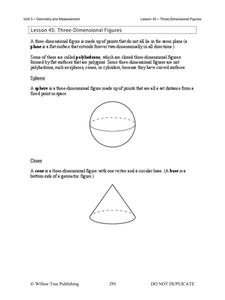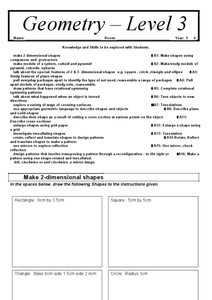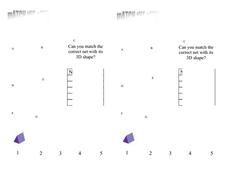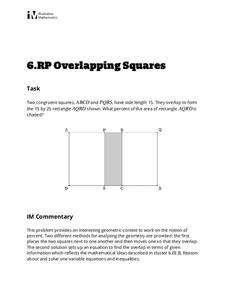Curated OER
2-Dimensional Shapes: Looking at Shapes
Help scholars identify shapes more thoroughly by counting their attributes. They examine eight 2-dimensional shapes, recording the number of sides and corners for each writing the name. Consider creating a class poster together before or...
Curated OER
Naming 2-Dimensional Shapes
Inside each of these two-dimensional shapes, scholars identify the figure by writing its name. There is a word bank for them to work from, but some shape names are used multiple times. There are six identifiers they use: pentagon,...
Curated OER
Sorting 2-Dimensional Shapes
Explore shape attributes with young geometers as they sort nine shapes based on their corners. Scholars determine whether or not each shape has a square corner, drawing it in the appropriate space accordingly. They are encouraged to use...
Centre for Innovation in Mamatics Teaching
Area, Perimeter and Volume
Develop young mathematicians' knowledge of two- and three-dimensional shapes with this geometry workbook. From learning about the classifications of different shapes and figures to calculating their area, perimeter, and volume, this...
Curated OER
2-Dimensional Shapes: Coloring Shapes
For beginners to color, number, and shape theory, this is a great way to solidify skills. They use a key at the top to determine which color (yellow, green, purple, or blue) to shade each shape (square, triangle, circle, and rectangle,...
Learner
Solid Shapes
A collection of two lessons, kindergartners will identify two-dimensional shapes in solid shapes. They will develop basic knowledge of the components that make up a sphere, rectangular prism, pyramid, cylinder, cone, and cube. Young...
Willow Tree
Three-Dimensional Figures
Time to move into the third dimension! Learn the names of the geometric solids and count faces, edges, and vertices. Then learn to recognize nets that create a given solid.
Curated OER
Geometry Level 3
What a wonderful resource! Learners create two-dimensional shapes according to the instructions stated, use the squares to make a triangular prism, a cube, and a pyramid, and identify features of plane shapes, among a myriad of other...
National Security Agency
Classifying Triangles
Building on young mathematicians' prior knowledge of three-sided shapes, this activity series explores the defining characteristics of different types of triangles. Starting with a shared reading of the children's book The Greedy...
Curated OER
Shapes: Art or Geometry
Budding artists or mathematicians read about,and then draw, two very different shapes. Geometric and organic 2-D shapes are defined. Learners use the definitions to draw examples of each.
It's About Time
Center of Mass
Lead your class on an exploration as they locate the center of mass in several oddly shaped two-dimensional objects they create from their imaginations. Pupils also determine the location of the center of mass in three-dimensional...
Curated OER
Countdown Challenge: Platonic Solids - Part I
Use a Platonic solids worksheet to record the number of faces, edges, and vertices of five polyhedra whose faces, edges, and vertices are all identical. For each figure, learners write a proof of Euler's formula (F+V=E+2). They create a...
Charleston School District
Volume of Rounded Objects
How much can different shapes hold? The answer varies depending on the shape and dimensions. Individuals learn the formulas for the volume of a sphere, cone, and cylinder. They apply the formulas to find the volume of these...
Technical Sketching
Introduction — Surfaces and Edges
How different can 3-D and 2-D really be? An engineering resource provides an explanation about the importance of two-dimensional technical drawings. Several samples show how to create multi-view drawings from pictorials and vice-versa....
National Security Agency
Awesome Area - Geometry and Measurement
Break out those math manipulatives, it's time to teach about area! Capturing the engagement of young mathematicians, this three-lesson series supports children with learning how to measure the area of squares, rectangles, and other...
Virginia Department of Education
Geometry and Volume
The history of math is fascinating! Utilize a woodcut primary source image from 1492 and posters from the 1930s to help geometers apply their volume-calculation skills to real-life questions.
Curated OER
Net C
In this learning tool instructional activity, 3rd graders cut and paste a template to create a cylinder. Students could color or decorate the cylinder.
Carnegie Mellon University
Technical Sketching Worksheets
How do you create a technical drawing? Cover the basics of technical sketching with a few practice sketches of simple shapes. A technical sketching lesson introduces the proper precision measurement techniques. Pupils progress to draw...
Curated OER
Match The Nets
For this math worksheet, learners match the drawings that are in pieces in order to create three dimensional geometric figures. They match the nets with the shapes.
Concord Consortium
The Six Faces of Amzora
Here's a task that is out of this world! Given a description of a fictional cube-shaped planet, scholars answer a set of questions about the planet. They create a two-dimensional map and consider the distances between locations on the map.
Curated OER
Art--"Paper Pasting"--Doing Collage
In this art worksheet, students read a 1 page article on the history or art, prepare their background to making a collage, gather basic shapes, create their collage and then add in the finishing touches to them.
Illustrative Mathematics
Overlapping Squares
The objective of this activity is to find the percent of the area of a two squares overlapping. Mathematicians find the ratio of area for the part that overlaps to the rectangle formed. The final answer is a percent as a rate per 100....
Curated OER
Narrow Corridor
Buying a new sofa? Learn how to use the Pythagorean Theorem, as well as algebra and graphing techniques, to determine whether the sofa will fit around a corner (which I'm sure you'll agree is a very important consideration!).
Youth Education Services
Relating Volume in 3D Objects with Ten Problems
A fabulous four-page assignment explores volume formulae for rectangular prisms, cylinders, cones, and pyramids. Pupils apply the formulas to solve problems, match diagrams to values, and address real-world scenarios. A detailed answer...

























